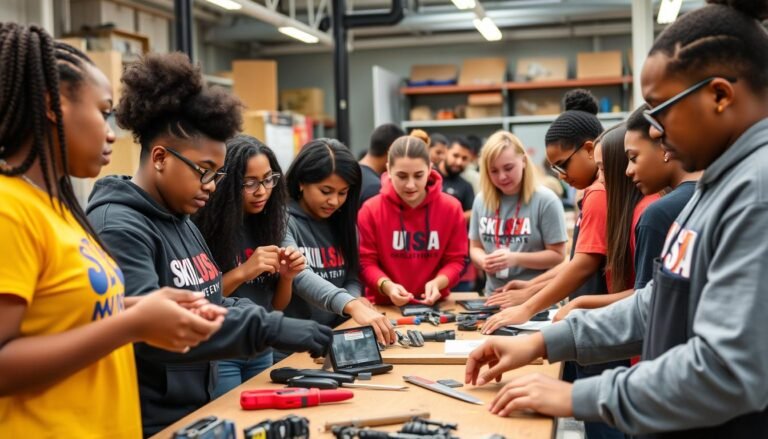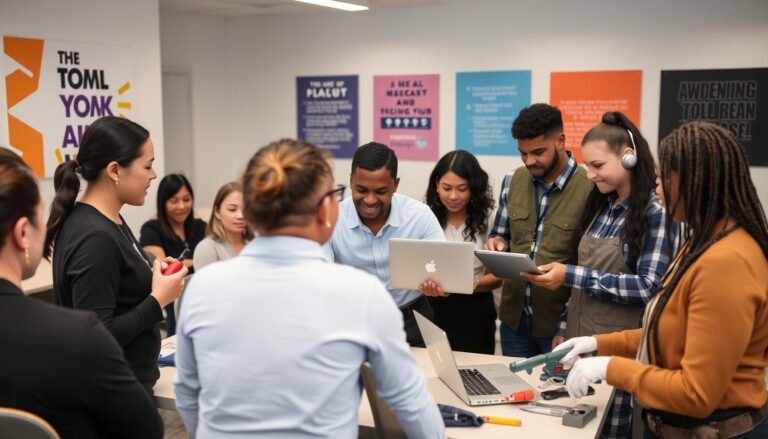Mastering Skills Machines: Boost Your Capabilities
Can machines really help us learn new skills faster and better than before? In our fast-changing world, skills machines are changing how we learn and grow. These tools, using artificial intelligence and machine learning, are making learning easier across many fields, from making things to being creative.
The U.S. Bureau of Labor Statistics says machine operators will grow by 4% from 2022 to 2032, creating 88,900 new jobs each year. This shows how important it is to learn about skills machines in areas like cars, planes, and food making.
A study with 7,000 learners found that focused practice makes skills better, no matter where you start. On average, people need about seven tries to get pretty good at most things. This shows how skills machines can speed up learning and improve abilities for all of us.
Key Takeaways
- Skills machines are changing how we grow and learn new skills
- Focused practice makes skills better in many subjects
- Machine learning algorithms make skills machines work better
- Artificial intelligence makes learning more flexible
- Skills machines help in making things, business, and creative work
Understanding the Power of Deliberate Practice
Mastering skills is more than just repeating them. It’s about focusing on deliberate practice. This method, based on cognitive psychology, changes how we learn and get better in different areas.
The Science Behind Skill Acquisition
Skill building has two kinds of memory: declarative and procedural. Declarative memory holds information we can recall with effort, like facts from a tutorial. Procedural memory, built through practice, lets us do things without thinking. This is crucial for mastering complex skills like coding or natural language processing.
Breaking Down Complex Skills into Manageable Parts
Deliberate practice means focusing on certain parts of a skill. For example, in data mining, you might keep practicing data cleaning techniques. This focused approach helps move knowledge from just knowing to being able to do it automatically, making you more skilled.
Embracing Failure as a Learning Opportunity
Stepping out of your comfort zone is key to growing. In text analytics, this could mean working on tough datasets. Facing failures in this way gives you important insights and helps you get better. Regular, focused practice leads to getting better at skills and mastering them.
“The journey to elite performance takes at least a decade.” – K. Anders Ericsson
Mastering skills like natural language processing or data mining is ongoing. It requires commitment, but with deliberate practice, you can see great results in your field.
Leveraging Technology for Skill Development
Technology is changing how we learn new skills today. With 68% of employees seeing training as key, companies are using new tech to meet this need. The training software market is expected to hit $115.49 billion by 2028, showing how big tech is in learning.
AI-Powered Learning Platforms
AI is making learning more personal. Language models and chatbots adjust to what each learner needs. They check how engaged learners are and change the content to keep them interested.
Simulations and Virtual Reality in Skill Training
Simulations and virtual reality are changing training. They let learners practice complex skills safely. Whether it’s for medical or manufacturing, VR training helps keep skills sharp and boosts performance.
Gamification of Learning Experiences
Gamification makes learning fun and engaging. Adding game elements to training gets more people involved and helps them remember more. It uses the competitive nature of learners to push them to improve.
| Technology | Benefit | Impact |
|---|---|---|
| AI Learning Platforms | Personalized Content | 24% increase in ROI |
| VR Simulations | Safe Practice Environment | Improved Skill Retention |
| Gamification | Increased Engagement | Higher Completion Rates |
With these new tech tools, companies that invest in training see a 95% boost in keeping employees. The global LMS market is growing, expected to hit $70.83 billion by 2030. Clearly, tech-driven learning is the way of the future.
Skills Machines: Revolutionizing Personal Growth
Skills machines are changing how we learn and grow. They use voice recognition, artificial intelligence, and machine learning to make learning personal. This new way of learning is making personal development more exciting, offering new ways to learn important skills like teamwork and leadership.
For example, Wharton Interactive has created “Top Gun for business” simulations. These games let students run virtual companies in real-time. They use tools that mimic real-world situations. The best part is, they give instant feedback and adjust the difficulty level based on how well you do.
Skills machines have a big impact on personal growth:
- Personalized learning paths boost engagement and knowledge retention
- Virtual reality enhances employee confidence and customer satisfaction
- AI-powered analytics identify skill gaps in real-time
- Chatbots offer on-demand assistance and tailored recommendations
The Aberdeen Group found that using microlearning increases effectiveness by 60%. A study at Dresden University showed that using AI and microlearning together makes answering questions 28% more efficient.
While skills machines have many benefits, it’s key to use them wisely. Mixing these tools with traditional methods like mentorship and networking can make learning even better. By using technology thoughtfully, we can discover new ways to grow and develop our skills.
Practical Applications of Skills Machines Across Industries
Skills machines are changing the way we work and learn in many areas. They use advanced technologies like natural language processing and data mining. This makes learning and working more efficient across different industries.
Manufacturing and Production
In manufacturing, skills machines help train machine operators. They use virtual labs for safe practice. This way, operators can learn complex tasks without making expensive mistakes.
This method helps with mistake-driven learning. It builds confidence and makes operators more skilled.
Business and Leadership
Business leaders get personalized learning paths from AI-powered platforms. These platforms use data mining to match content to what each person needs. The learning is broken into short, 15-minute modules, fitting into busy schedules.
There are also fun elements like leaderboards to keep learners interested. This makes learning skills more fun and effective.
Creative and Technical Fields
Creative people and engineers can access advanced tools remotely with skills machines. These systems use text analytics and natural language processing to understand what users need. They then provide the right resources.
This lets graphic designers and engineers use tools virtually. It encourages active learning and innovation in their work.
Source Links
- A Guide to Mastering Essential Machine Operator Skills
- The Machines of Mastery
- What is Skill Mastery? 5 Characteristics You Should Know – Legacee
- <br/>Master Any Skill with Deliberate Practice: The Key to Effective Learning — BABY BLOCKS
- Mastery through Deliberate Practice
- The Making of an Expert
- 7 Ways To Leverage Technologies for Corporate Training
- Leveraging Technology to Close the Skills Gap and Empower Your Workforce
- How AI is Revolutionizing Personal Development: The Next Big Thing!
- Revolutionizing Talent Development: AI-Powered Tools Shaping The Future Of Skills Enhancement
- Revolutionizing learning: The power of AI and VR in employee development
- 8 Ways To Elevate Engagement And Foster Practical Application In Skills Training
- AI Use Cases & Applications Across Major industries







